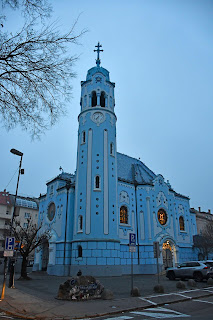Bratislava Day 2
Since I failed to enter the Blue Church on the previous day, I woke up at 6:00 the next morning to visit during the narrow slot when the church is open. From Monday to Saturday, its hours are 6:30-7:30 and 17:30-19:00, which leaves very little time for flexibility (or sleep). Skipping breakfast, I arrived at the church slowly after opening hours and took pictures as the congregation slowly trickled in.
For half an hour, the amplifiers boomed a
crackly recording of a monotonous female voice reading the Slovak Ave Maria and
Pater Noster. Some of the believers sat in silence, while others
repeated the prayers, taking advantage of the pauses in the recording. At
around seven, a priest began to officiate, and I hastily took my leave as I
felt making an exit in the middle of a mass would have been rather awkward.
It was a hazy morning. The darkness
departed only very slowly; indeed, I managed to eat a croissant and drink a
potent ginger tea at a nearby restaurant by the time the pitch-black night
turned into a deep grey dawn. Reluctantly, I carried on with my programme. I
walked down to the new Slovak National Theatre Building and the riverside,
where the national hero Milan Rastislav Štefánik looks out over the Danube.
Interestingly, following the direction of his gaze would lead one through
Austria to Hungary, the erewhile overlords of the Czech and Slovak nations.
I walked along the riverfront for a while
before crossing the Old Bridge to Janko Kráľ Park. Unbeknownst to me at the
time, the place prides itself on being the “oldest public park in Central
Europe,” which sounds like it could be a big or small claim depending on where
we draw the boundaries of Central Europe and how we define a public park. An
interesting feature is a former church tower converted to a bower. The gothic
gem was damaged during an earthquake and had to be replaced, but instead of
being destroyed entirely, it was lovingly relocated to the park.
Crossing the Bridge of the Slovak National
Uprising, I arrived at Saint Martin’s Cathedral. Although it was closed
yesterday, I was told the building would be open again from 9 AM, and so it
was. I found the Cathedral a bit strange. Despite its massive size, it emanates
the simplicity of a Central European village church, having few of the frills
that cathedrals abound with in Prague, Vienna, or London. Nevertheless, this is
where the kings of Hungary were crowned for a quarter of a millennium, between
the years 1563 (shortly after Székesfehérvár was taken by the Ottomans) and
1830.
My dad arrived at midday by car, which
offered the perfect opportunity to visit more distant and more elevated places.
As the mist suddenly cleared up, we stopped on the southern shore of the Danube
to look at the city in its full glory before driving west to the castle Devín. The castle,
whose origins date to the Great Moravian Empire, is majorly associated with the
Slovak National Revival, featuring in the works of Ján Kollár and Ján Hollý.
Significantly, it is located at the confluence of the Danube and Morava.
After our excursion to Devín, we returned
to Bratislava, enveloped in the meantime by a thick fog. The weather was very
changeable that day, which we attributed to the influence of the vast Danube. We
visited the Church of Our Lady of the Snows, which stands at the top of a local
Calvary and sacred grotto, as well as Slavín, a memorial to the Soviet soldiers who died
in the liberation of Bratislava. I believe the hill is meant to offer nice
views of the town, but due to the fog we could barely even see the top of the
monument.
Because we had skipped lunch and subsisted
on tangerines, we still had some daylight to spare. We decided, therefore, to
make one last visit. While searching for tourist attractions on google maps, I
came across a Roman outpost called Gerulata just south of Bratislava.
Allegedly, Marcus Aurelius wrote a significant portion of his Meditations in
the area; the Danube was, after all, one of the natural boundaries of the Roman
Empire.
Nevertheless, it would have been impossible
to make my dad interested in what appeared to be a few pillar bases and some
broken stones. Instead, I searched along the Danube until I came across a much
more well-preserved settlement just across the Austrian border. Capital of the
Pannonia Superior Province, the city of Carnuntum had 50,000 inhabitants, and
its ruins include an amphitheatre for 15,000 spectators and a massive monument
possibly built by Constantinus II.
On our way to Carnuntum, we also stopped by
the town of Hainburg an der Donau, once home to a young Joseph Haydn. Besides a
few pretty gates and towers, Hainburg also boasts some presumably impressive
castle ruins which loom over the city from a nearby hill. I say “presumably,”
as we could hardly see them through the fog, and only had a vague impression of
their size despite hiking all the way up and peering out from the walls into
vast nothingness.
The castle has had a long and interesting
history. The hill it rests on was first settled by Illyrians and Celts, but the
first proper castle was built in 1050 by Holy Roman Emperor Henry III. In the
1220s, the castle walls were reinforced using ransom received for Richard the
Lionheart, who had been captured – contrary to medieval public law banning the
detention of crusaders – by Leopold of Austria. While Leopold was
excommunicated for this transgression by the Pope, Richard I passed into the
hands of Holy Roman Emperor Henry VI, who only let the king go for a hefty sum.
The castle was destroyed in 1683 by the
Second Ottoman Campaign during an attack that killed 8000 people.
























































Comments
Post a Comment